Alan (A.J.) Fischer says he can prove the violence at the Capitol on Jan. 6 was incited by police brutality and their illegal use of force, not "insurrectionist" Trump supporters. The first hour of the J6 protests was a critical period of time, according to Fischer. During the protesters' first few minutes of the first hour on Capitol grounds, officers from the Capitol Police and Metro DC Police allegedly used illegal force and brutality on what was overwhelmingly a peaceful crowd. And they did it, says Fischer, "without proper lawful warning or regard for statutory procedures."
Fischer calls this first hour "The USCP and MPD' Less Lethal' Timeline." He believes "these initial moments amount to evidence that sets the tone for the rest of the day and created the civil disorder (18 U.S. Code § 231) that he and other J6 defendants have been charged with." He believes that if fairly presented at trial, evidence would result in the dismissal of most J6 cases.
A member of the Proud Boys, Fischer walked onto the Capitol grounds through the Peace Circle just before 1 PM. Between 12:59 PM and 2:03 PM, as Fischer shows in his "X" post below, "Police munitions occurred BEFORE a riot was declared at 1:49 PM, and BEFORE The Capitol was 'stormed' from 2:10 – 2:30 PM." These are facts the House Select Committee on J6 never wants you to see.
It makes you wonder what Rep. Loudermilk really knew or meant when he said, "Our officers on the line did what they needed to do at the time." Much of the first hour is also documented in this rumble video from StopHate.com.
Did Protesters Know Not to Enter?: Breach #1 and Snow Fencing
Breach #1, according to Fischer's investigation, occurred at 12:45 at the "barricades blocking a path at the Peace Circle, a few hundred yards from the Capitol off of 1st St NW. Those barricades were pushed over by a handful of protesters."
"Protesters filled the Lower West Plaza outside the Capitol Building shortly after," says Fischer. "This first push of the barricades is 'defined as Breach #1 by the media and the DOJ.' It is the famous fence push involving Ryan Samsel and Ray Epps. After the Samsel/ Epps fence push at the Peace Circle, anyone walking behind them would be clueless as to what just happened because the bike racks blocking the path were removed."
Fischer also notes that snow fencing with signage affixed was blocking off the grassy areas of the West Lawn. According to Fischer, neither he nor most of the other protesters ever even saw it! It had already been removed. The snow fencing is important because it had signage attached to it that said "Area Closed." And yet, says Fischer, "The DOJ continues to condemn protesters, saying they should have known better" than to enter a restricted area.
Fischer and his team found footage showing that at around 12:55 PM, someone began removing the "flimsy snow fencing" with signs affixed to it indicating it was a restricted area. The bike racks had been removed prior to his arrival through the Peace Circle. Fischer says he saw "no sign of any restricted area on Capitol grounds." Oddly, "the individuals who removed the fencing have never been identified or arrested, says Fischer.
Sure enough, video evidence shows a yet-to-be-identified man ("the scaffold commander") who was "one of the first to push down fences and enter the lawn." He is allegedly the same person who removed the snow fencing.
 Scaffold Commander
Scaffold Commander
 Unidentified Scaffold Commander Removes Snow Fencing
Unidentified Scaffold Commander Removes Snow Fencing
The First Hour: Open Letter to Tarik Johnson
Fischer calls this first hour "The USCP and MPD' Less Lethal' Timeline" on his InvestigageJ6 website. According to Fischer, law enforcement failed to follow the D.C. law, First Amendment Assemblies statute 5-331-07. The law clearly outlines the rules for engagement for law enforcement concerning the lawful clearing of mass demonstration events.
Specifically, Fischer alleges law enforcement failed to adequately inform or warn the crowd. They also failed to identify reasonable paths for dispersal. Fischer identifies with timestamps that warnings were given much later, well after officers allegedly began inciting the crowd with munitions. According to Fischer, "The first recorded warning given, found in officer bodycam footage, came from D.C. officers one hour later, using an LRAD unit at 2:03 PM before authorizing C.S. gas at 2:10 PM.
Fischer documents the timeline of events in an "open letter" to former Capitol Police Lieutenant Tarik Johnson, who requested more information on Aug. 17, 2023. Johnson asks for evidence of police-instigated violence. Notably, Fischer told UncoverDC that Johnson knows orders to "launch" were given:
"Officer Johnson knows that Waldow gave the order. He was on the same radio channel (inside) that day as Unit 6 (Waldow) gave the orders. What he didn't know was that the required warnings were never fulfilled. I intend to prove that the orders Tarik knows were given by Waldow and Loyd were, in fact, unjustified and illegal, and that Waldow knowingly lied by saying he gave warnings when he did not."
With his open letter, Fischer asks and answers a critical question for J6 defendants, "Was the escalation of force that preceded all events on Jan. 6 required and lawful?" Not only does Fischer believe he has proven it was not required nor was it lawful for the police to use force during the referenced time period, but he also believes his investigation blows the lid off every narrative stating Trump supporters intended to riot, cause violence, attack police and politicians, or later "storm" the building.
Notably, Fischer also cites reporting from the Epoch Times that allegedly shows Waldow lied about projectiles being thrown before his orders to engage. Fischer says Waldow "also lies about giving warnings at the time. He didn't." The Epoch Times transcribed Waldow's 1:06 PM radio transmission below:
"I got a crowd fighting with officers, pushing, throwing projectiles," [Waldow] broadcast. "I have given warnings about chemical munitions. I need the less-than-lethal team positioned above me to identify the agitators and start deploying. Launch, launch, launch!"
"The video, writes the Epoch Times, "Shot with a camera on an elevated stick, doesn't show fighting or projectiles being thrown in the area where Deputy Chief Waldow stood at 1:06 PM and where force was about to be deployed."
Fischer summarizes what he witnessed during the first hour below:
"Within the first minutes of protestors arriving at the Capitol on Jan. 6 at 1:00 PM, Deputy Chief Waldow misrepresented conditions on the ground in radio transmissions to justify escalating force, and in effect, incited protestors to violence. There is no evidence he or his officers gave any sufficient warnings before or after opening fire, contrary to his claims. The first recorded warning given, found in officer bodycam footage, came from D.C. officers one hour later, using an LRAD unit at 2:03 PM before authorizing C.S. gas at 2:10 PM.
A Brief Look at Fischer's "Less Lethal" Timeline
This article will not review the blow-by-blow of Fischer's timeline. It is easily referenced on his website. Instead, the first few minutes adequately preview what unfolds in the critically important first hour of the protests.
Fischer described to UncoverDC the contagious and creeping fear as the crowd realized police were attacking it. "I witnessed a peaceful crowd caught completely off guard become increasingly agitated, and witnessed multitudes of protestors who were peaceful, be incited to violence by continued unrelenting attacks." Individuals began to defend themselves and others from injury from what he says were "heavy-handed attacks; baton strikes, chemical sprays, tasing, shoving and then the unrelenting mortar and grenade explosives." The "less-than-lethal force by the police was unwarranted at the time," says Fischer:
"Upon review of the footage, there were a few agitators, but it was 1 to 1,000. One was Landon Copeland, an admitted ANTIFA member who is seen after the first shot pushing cops and pushing protestors into police lines to create skirmishes. Prior to the shot, there was almost no violence; certainly no violence that anyone could see as they filtered in."
However, it is important to note that law enforcement waited over an hour to begin following D.C. law. Fischer believes that had the officers involved "followed D.C. law and the protocol outlined in Jan. 5 USCP Use Of Force directive 1020.004, they might have been able to de-escalate the event instead." The USCP Use of Force directive specifically states, "Impact projectiles will not be fired indiscriminately into crowds." Yet that seems precisely what law enforcement did within moments of the initial "breaches" of the surrounding grounds.
According to Fischer's reconstructed timeline, at 12:59 PM, Waldow radioed the "Less than Lethal" Team, ordering them to "take an elevated position." One minute later, the Team moved into place in an octagon-shaped "sniper's nest" on the West terrace's inauguration stage.
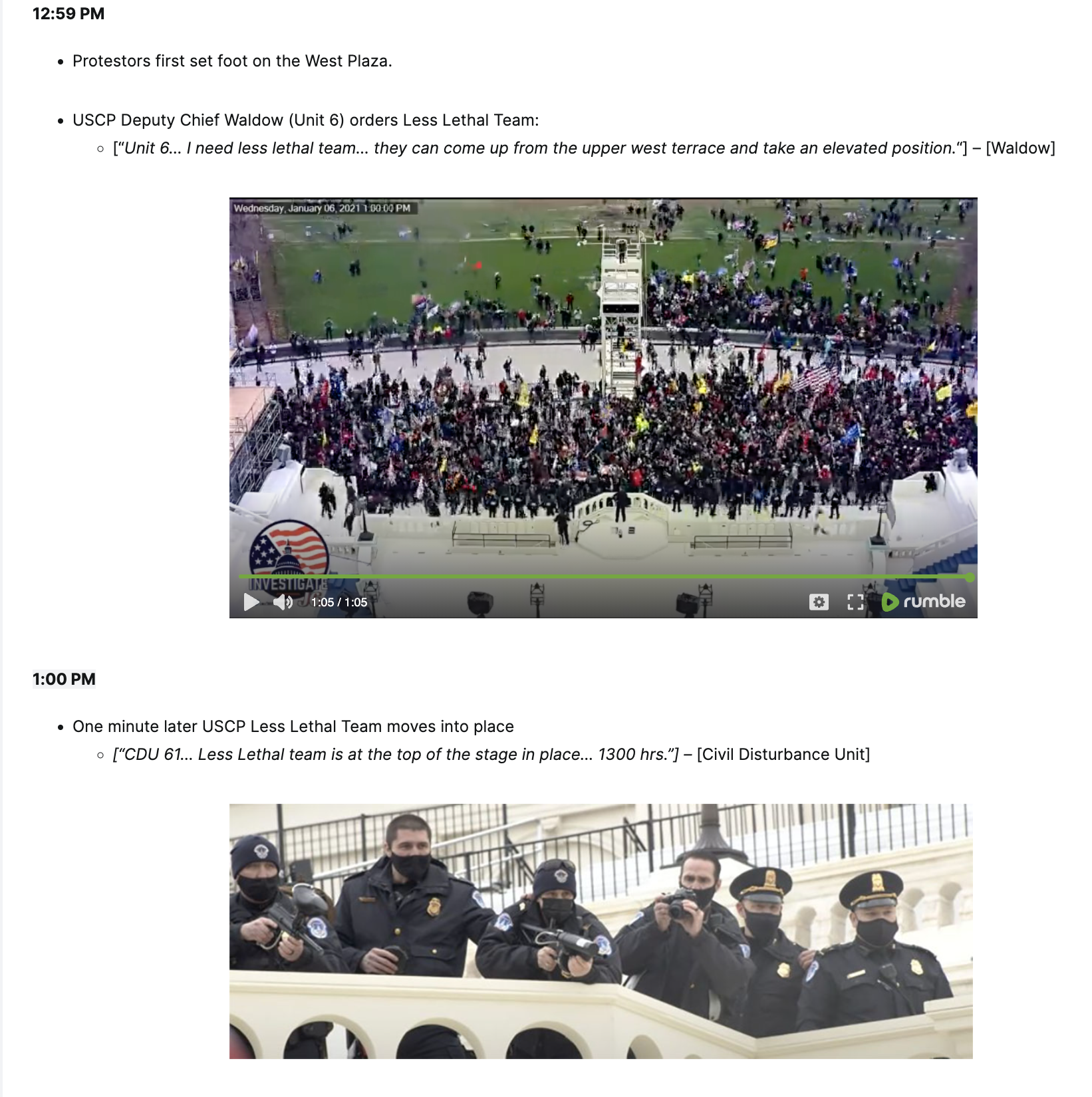 First Minute Waldow/InvestigateJ6
First Minute Waldow/InvestigateJ6
Fischer's timeline indicates that at 1:06 PM, Waldow orders his "Less than Lethal Team" (his words) to "Launch." Moments later, USCP Inspector Lloyd points, giving the Less than Lethal team a hand signal to fire into the crowd. Shortly after that, officers from the Metro Police Department (DCMPD) began to arrive. All is documented in the timeline on the Investigate J6 website. Waldow's orders are heard in the video below:
According to Fischer, "Waldow was lying on his radio transmissions saying that he was giving the legally required warnings, that he never gave. Neither he nor his officers ever ordered the crowd to disperse." Fischer's observations are confirmed in video footage. However, Fischer also adds,
"USCP Capitol Control Center comms have never been released, and it's not clear if Pittman and others directed Waldow and the less-than-lethal team's assaults, although they may have. The initial orders to use less than lethal force are illegal. I have identified the officers responsible for the worst police brutality, the instigators, and the ones who broke the law.
Deputy Chief Eric Waldow was lying on his radio transmissions, saying that he was giving the legally required warnings, but he never did. Neither he nor his officers ever ordered the crowd to disperse.
Those warnings are legally required by the D.C. First Amendment Assemblies statute 5-331.07. The statute says that you have to give three clearly audible warnings and an opportunity to exit to First Amendment Assemblies before dispersing the crowd, before escalating to the less-than-lethal munitions like the ones they used. They were using projectile and explosive munitions. So in his radio transmissions, as soon as people got on that lower West Plaza, he calls the Less than Lethal team to go into place and then asks them to launch munitions on the crowd."
Law enforcement could have chosen to arrest the few disruptive protesters per D.C. law and de-escalate the crowd that way. They did nothing of the sort.
At around 1:15 PM, Fischer was sprayed with pepper spray by D.C. police, and then at 1:18 PM, he was "shot in the face with a pepper ball munition which exploded upon impact on his left temple." Fischer is in a black hood and sunglasses. His stepfather, a retired 9/11 firefighter, is also pictured. You can see traces of the residue on his hood near his left temple. Others were also injured during this time.
 Fischer/Pepper Ball/Hit/1:18 p.m. J6
Fischer/Pepper Ball/Hit/1:18 p.m. J6
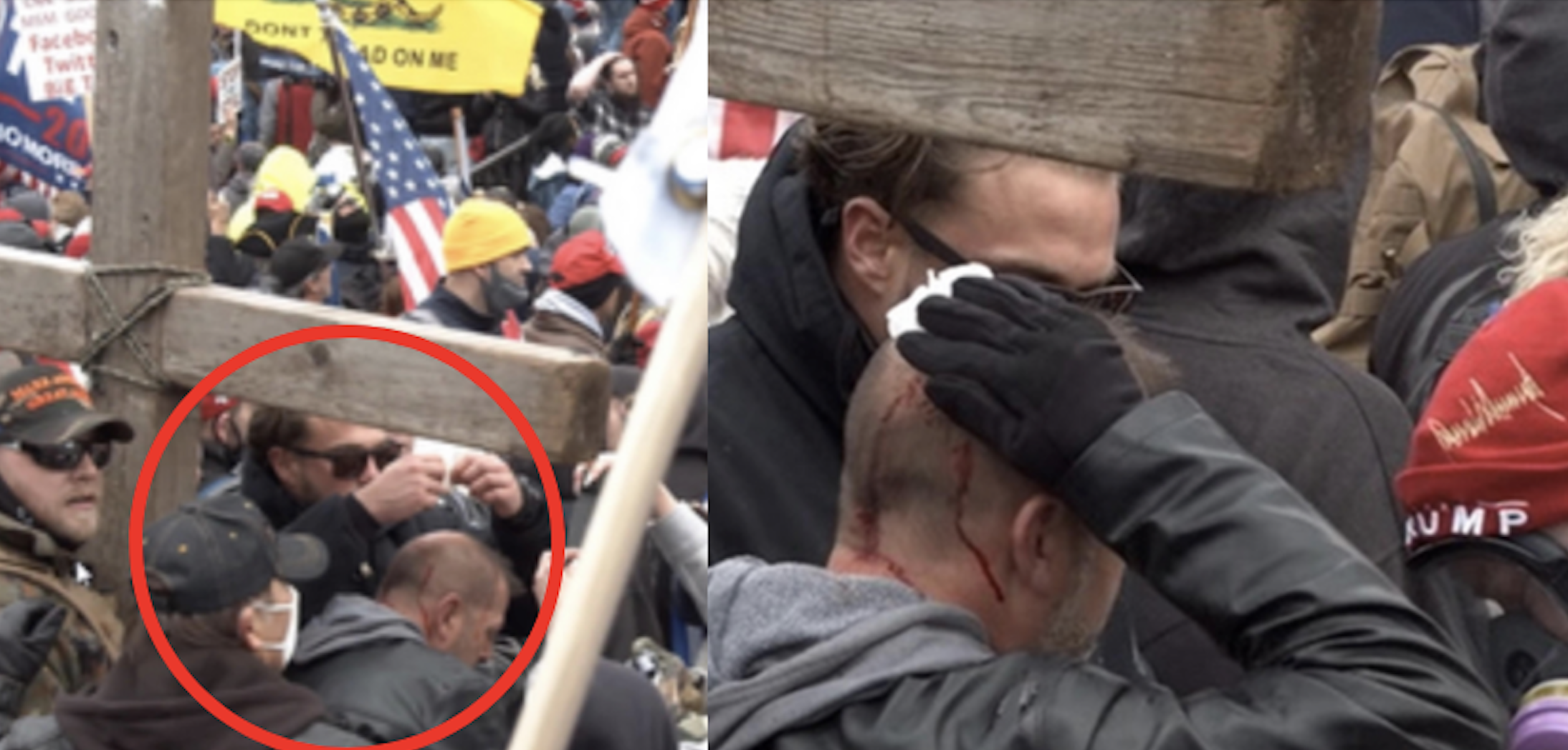 Injured by Munitions
Injured by Munitions
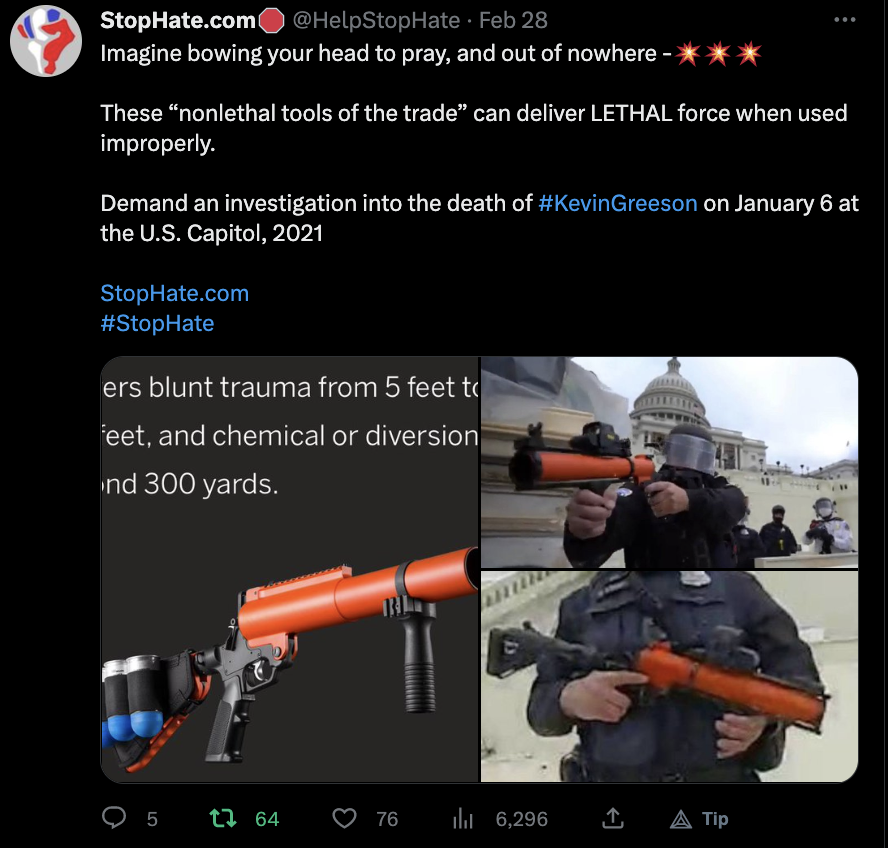 Munitions Used/J6/StopHate.com
Munitions Used/J6/StopHate.com
The Epoch Times reported, "pepper ball munitions can travel up to three hundred feet per second." They can maim and kill. USCP Officer Shae Cooney testified in the Proud Boys trial that yes, it is "possibl[e]" they can kill. She also admitted it is a violation of policy to shoot someone in the temple with one. Journalist Roger Parloff live-tweeted the trial with the referenced munitions below. Officer Cooney was on the stand:
Fischer confirms that he and others were "peacefully" standing in the crowd when they were hit with potentially lethal munitions, as confirmed by DC MPD Officer Cooney during the Proud Boys trial:
"I was feet from Ray Epps and many of these characters that people know of. I saw it all go down. I was standing next to Joshua Black when he was shot in the cheek. And that was the first shot. That was 1:07.
They fired twice more," Fischer continued, "At 1:10 PM and then at 1:18 PM. Then at 1:18, DC MPD Sargeant Thau, USCP Deputy Chief Waldow, and USCP Inspector Lloyd ordered the less-than-lethal team to shoot into the crowd. That is when I was shot in the face with a pepper ball. Sargeant Thau had requested Capitol Police provide him with blast munitions to throw at a mostly peaceful crowd at 1:13.
The DC MPD arrived around 1:20 PM and after with blast munitions. At 1:21 PM, the first grenade is heard going off on DC MPD Officer Crisman's body cam. And then you can see DC MPD Commander Robert Glover authorize Crisman to start throwing stingball grenades. Between 1:32 and 1:36 PM,13 explosive munitions in a row are fired into the crowd."
D.C. Law Determines Rules of Engagement for Clearing Mass Demonstration Events
So, what are the known rules of engagement during a mass demonstration event? To summarize, the First Amendment Assemblies statute essentially states the following:
- First, officers must seek to "enforce restrictions through voluntary compliance and then seek, as appropriate, to enforce the restrictions by issuing citations to, or by arresting, the specific non-compliant persons..."
- Officers must "issue at least 3 clearly audible and understandable orders to disperse using an amplification system or device, waiting at least 2 minutes between the issuance of each warning." The referenced system used should be the LRAD system. LRAD are long-range acoustic devices that "ensure every broadcast is clearly heard and understood, even above the crowd, engine, and background noise."
- Protesters must also be able to hear the warnings.
- The order to disperse must be authorized by specific personnel. The manner of dispersion must be organized by following specific guidelines. Officers must inform, warn, and identify as specified in the screenshot below, pulled from the D.C. Law:
 https://code.dccouncil.gov/us/dc/council/code/sections/5-331.07
https://code.dccouncil.gov/us/dc/council/code/sections/5-331.07
Lafayette Park Protests: Jonathan Turley Testimony
As a point of reference, Fischer looked at how law enforcement handled the violent protests on Memorial Day 2020 in Lafayette Park near the White House. The hearing following the Lafayette Park protests bears examination if one is to honestly examine how law enforcement handled the J6 protest. Oddly enough, in stark contrast to any J6 hearing, this Democrat-run House Natural Resources Committee hearing was named the "U.S. Park Police Attack on Peaceful Protesters at Lafayette Square." The name couldn't be further from the truth. It was an entire weekend of riots, with "protesters" firebombing the White House and nearly burning St. John's church to the ground. 750 law enforcement officers were injured. Perhaps if the House Select Committee on J6 had heard the same testimony used as a defense for "protesters" in the Lafayette Park Inquiry, things could have panned out very differently for J6ers.
Fischer looked at the Jun. 29, 2020, Oversight Hearing, where Jonathan Turley, Lawyer and Professor of Public Interest Law at George Washington University Law School, provided his legal expertise on the law enforcement protocols during the mass demonstration event concerning the "The U.S. Park Police Attack on Peaceful Protesters at Lafayette Square Park."
Turley identifies the "purpose, timing, and means" by which law enforcement operates during mass demonstrations. He relied upon his experience as "one of several lead counsels" in the 14-year World Bank protest litigation. Interestingly, unlike the J6 cases, the World Bank protest was settled. Judge Emmett Sullivan awarded "a total of $2.8 million" to four plaintiffs who allegedly proved "police used 'trap and detain' methods" to unlawfully arrest and detain them.
Why is this case foundational to J6? Well, because the Honorable Emmet Sullivan of the United States District Court for the District of Columbia, per Turley's testimony, reaffirmed what is now D.C. law:
"[T]he Park Police, as well as the MPD, could not enclose or otherwise prevent demonstrators from leaving areas of unlawful gatherings. Warnings were to be repeated three times with sufficient amplification and separation to allow both officers and citizens to understand the order to disperse. Moreover, reasonable exits would be available after warnings are given. The court further emphasized the need for probable cause and the ability to identify the individuals who commit illegal acts before arrests are made."
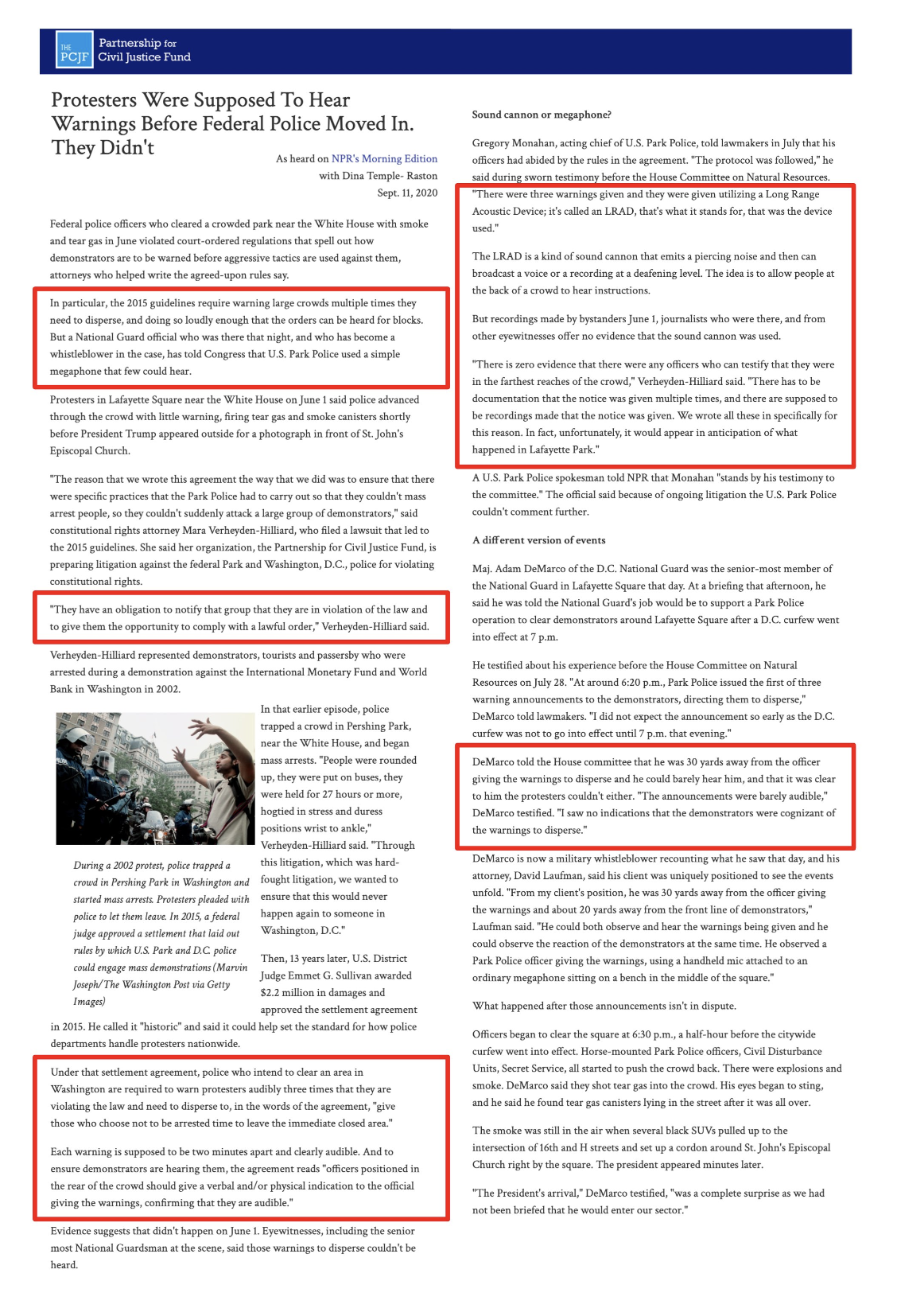 D.C. Law Lafayette Park Protests/https://www.justiceonline.org/protesters_were_supposed_to_hear_warnings_before_federal_police_moved_in_they_didn_t
D.C. Law Lafayette Park Protests/https://www.justiceonline.org/protesters_were_supposed_to_hear_warnings_before_federal_police_moved_in_they_didn_t
So why was J6 handled so differently? Many questions remain. However, Turley implies the Lafayette protests have been politicized or "framed by one overarching narrative" that the "park was cleared for a photo op for President Donald Trump outside of St. John's Church," as if to imply the photo op made the violence any less egregious. "The widespread claim," concludes Turley in his testimony, "that the Park was cleared for the Trump photo op is currently unsupported and contradicted by the available evidence." Nevertheless, Turley asserts, photo op or no photo op—the unlawful manner of clearing the park warrants introspection all on its own.
It is common to see reporting characterizing J6 as an insurrection and the Lafayette Park protests as peaceful. In a 2021 article, Turley says the Lafayette protests are prone to "revisionist" history, attempting to assert Lafayette protests were peaceful when they, in fact, were not. The Lafayette protests went on for several days, injuring many officers. The violence caused the extrication of the President to an underground bunker. Turley describes the violence and clarifies the reason for clearing the surrounding grounds:
Some 150 officers were injured during the protests, and half of those were injured around the White House. The Justice Department claimed 750 injured officers during the various protests. What is clear that is dozens of officers were injured, and there are videotapes of officers hit by frozen bottles, bricks, and other missiles. For two days, the violence continued with the burning of a historic structure, extensive property damage, and the attempted burning down of the historic St. John's Church. The attacks around the complex were so great that the President was moved into the bunker, and officers said that they were concerned that the complex might be breached.
The Lafayette Park protests occurred over multiple days and the clearing operation was ordered as a result of a decision made before the final day to establish a greater perimeter to protect the White House complex and [the] immediate surrounding area."
Turley also makes it clear that even when exercising First Amendment speech, protesters are obligated to heed law enforcement officers who lawfully deliver requests to disperse. According to Fischer, J6 defendants were never afforded the lawful dispersal protocols. Many are now spending decades in federal prison for acts that in other similar "protests" went all but unpunished.
The 2017 Inauguration and Kavanaugh Protests
Fischer also references the violent "J20 2017" inaugural day protests and the earlier 2018 Kavanaugh protests to fortify his case further that the DOJ has been weaponized against J6ers. He cites a Vdare.com article comparing Jan. 20, 2017 (J20) to J6.
The "J20" inauguration prompted untold amounts of damage in the Capitol, allegedly planned and committed by Antifa anarchists and communists.
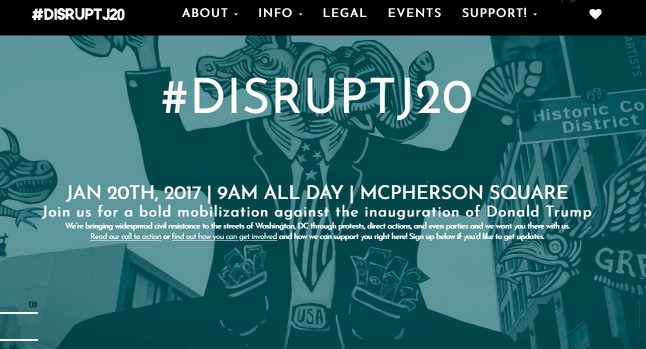
 Disrupt J20
Disrupt J20
Protesters "threw rocks, smashed windows assaulted police with projectiles, terrified customers in businesses they vandalized, and set SUVs on fire, destroying them, all in hopes of stopping the peaceful transfer of power after the lawful election of President Trump." Only two defendants were convicted. Both had their sentences suspended. According to Vdare, of the 235 defendants charged, only one did jail time—for four months. The Capitol Breach cases currently stand at over 1100 and counting.
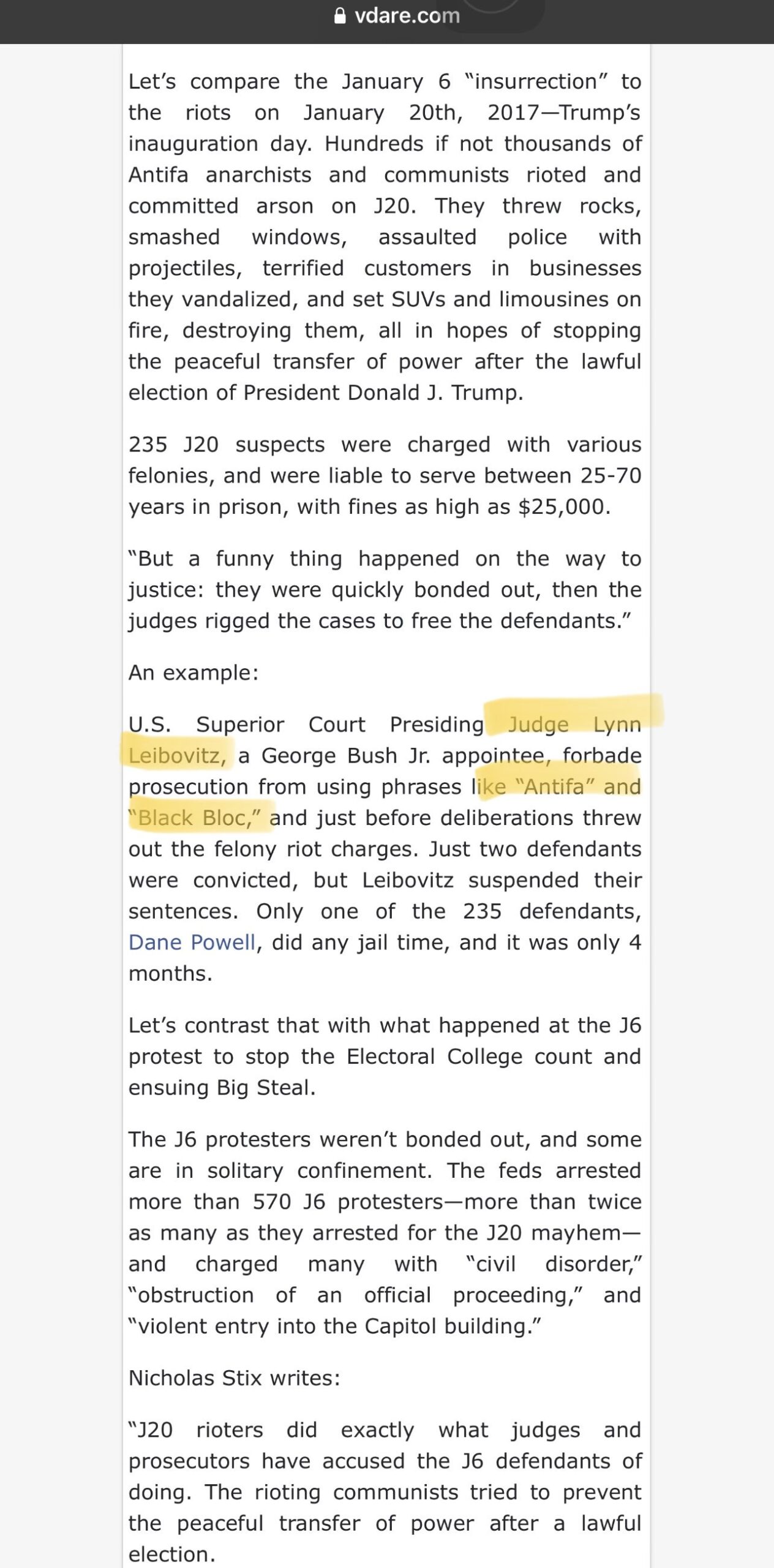 J20/2017
J20/2017
In addition, Fischer pushes back against using the word "breach" to describe the initial moments of the J6 protests. For example, the term was never used to describe protesters during the Kavanaugh hearings. He believes it has been a purposeful mischaracterization of Breach #1, saying the language conveniently sets the stage "for a felony charge."
Fischer highlights reporting on the Kavanaugh protests, where protesters are described as having simply "ignored barricades ahead of the Kavanaugh vote." Perhaps it is because those protesters were likely not Trump supporters. Make of it what you may.
The reporting of the Kavanaugh protests states individuals "crossed police lines." However, the footage shows some who force themselves inside the Chamber to interrupt the final vote. In addition, many were arrested, but there was no talk of "insurrection" in news reports in the following days and weeks. None of those protesters were or are incarcerated in federal prison. Finally, citing CNN, Fischer states Kavanaugh protesters, per the CNN video, "paid $50 bail and were then released. Those charges did not remain on their criminal record."
 Kavanaugh 2/Fischer
Kavanaugh 2/Fischer
During the J6 protests, law enforcement used harmful munitions like explosive and incendiary grenades, mortars, and tear gas to disperse crowds, allegedly without lawful warning or following lawful procedures. Turley cites multiple other court cases that outright "ban the use of tear gas, despite evidence from police of assaults on officers, looting and property destruction." Turley also cites a Ninth Circuit ruling that "the proper [police] response" doesn't give law enforcement carte blanche to lob munitions at random First Amendment protesters. Instead, police should be specific by "arresting those who actually engage in such conduct."
 Turley/
Turley/
Plenty of legal precedents cite the lawful crowd-clearing methods, including robust LRAD warning systems that can be heard, adherence to the proper means and manner of disbursement of crowds, and other lawful de-escalatory means of clearing the conflict. In many instances, plaintiffs won the cases that proved officers failed to follow the law.
Notably, Mayor Muriel Bowser signed a "sweeping police reform bill" in June 2020 "to limit the use of force by police, release body camera footage more quickly, and limit the role of the police union in the police disciplinary process. The council voted [unanimously] to prohibit D.C. police from using tear gas, pepper spray, rubber bullets or stun grenades to disperse a crowd."
Fischer wonders what happened to that law and other laws on Jan. 6. He hopes to prove that most J6 defendants who have been sentenced to federal prison were not insurrectionists but were relatively peaceful, lawful First Amendment protesters incited to violence through the unlawful actions of the Capitol and Metro D.C. police. Incidentally, Fischer gave a slide deck to Rep. Jim Jordan on May 4, 2023, and Rep. Thomas Massie the first week of Sept. 2023. The slide deck, which UncoverDC has seen, details evidence of the unlawful use of force unleashed on peaceful protesters before the Capitol Building was "stormed" on Jan. 6.


